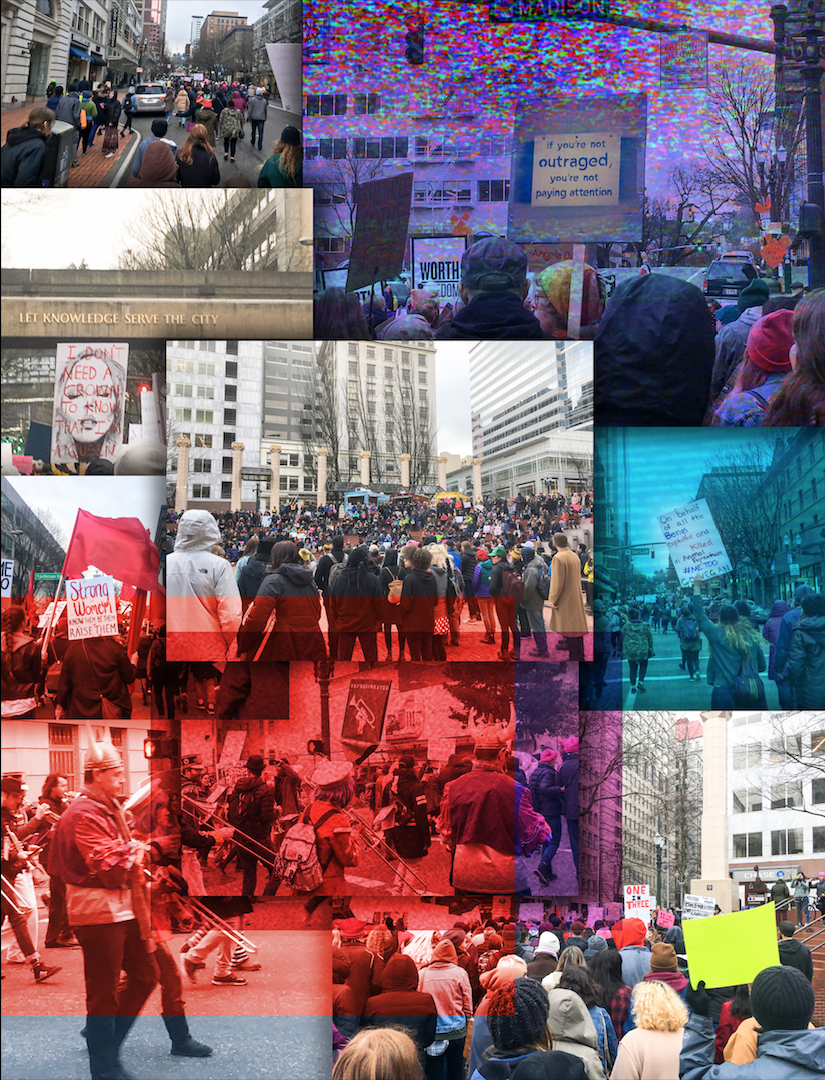From protests to proactive?
Portland's marches evolve in a positive direction

Cover by Fletcher Wold
Cover Photos by: Kyle Vanooker, Bethany McCurley
The past weekend, Jan. 20-21, marked the one-year anniversary of a series of protests that rocked the streets of Portland: the Portland Women’s March and the J20 inaugural protests.
As your faithful and tireless editorial staff reported last year, the two protests that day had a very different tenor.
The Women’s March, a sister protest of solidarity with the Women’s March on Washington and part of a nationwide movement which attracted supporters in the tens of millions across the country, was a massive, well-organized, largely positive and fun assembly that filed a permit with the city.
J20, by contrast, filed no permit, and was much more loosely organized; as one reporter with the Advocate recalled, “By the time we reached the Burnside Bridge, I found myself face-to-face with a line of impassive police in full riot gear, batons out… I watched a man… shouting ‘F#@k Ted Wheeler!’… get pepper sprayed.” (For the full recap of last year’s protest, readers can search “protest” on the Advocate’s website, www.advocate-online.net)
This year’s protests showed a marked difference in contrast to the passion, and occasional violence, of last year’s assemblies. This year, protests were split into several events. Saturday saw nonprofit organization NXT LVL teaming up with the magazine She Shreds for a rally-cum-party lasting until 2 a.m., while earlier in the day there was a march for the impeachment of President Donald Trump, as well as another gathering to express solidarity with the #MeToo movement. On Sunday, the weekend rallies culminated with the Indigenous Womxn’s March.
It seems as though there was an emphasis, at least in Portland, on highlighting the diversity (and the struggle to increase said diversity) in the contemporary feminist movement. Organizers of last year’s Women’s March were quoted on KATU-TV’s website as intentionally “creat[ing] space for Indigenous Womxn to be seen and heard,” while the NXT LVL event showcased people of color and members of the queer community, with proceeds going to Brown Girl Rise and Queer Rock Camp.
But has this expansion of protest options contributed to, or fallen victim to, a dissipation of energy?
The Portland Women’s March in 2017 boasted attendance of upwards of 70,000 people. While crowd estimates have yet to be released, the number who attended all three marches this time was significantly smaller.
That’s not just a phenomenon specific to Portland. Across the nation, the numbers seen on the first anniversary pale in comparison to the millions of people who poured into the streets last year.
If the current public discourse is any indicator, however, passion for equal rights and dignity for woman hasn’t tapered off.
So, what gives?
Part of it, no doubt, has to do how fresh the wounds were last January. A scant two months had passed since the “Hollywood Access” tapes, in which Trump uttered his now-infamous “grab her by the pussy” line, were made public. The phrase spawned the “pink pussy” hats sported by many a marcher (and dusted off and displayed at the anniversary, too) in 2017.
The people of America have now had a whole year to get used to Trump’s bluster and bullshit, so maybe the raw, unburnished passion so evidently on display last year has diminished, or at least mellowed.
A strategic shift in focus, however, might be another aspect.
The organizers of the 2017 Women’s March set up a political rally in Las Vegas this year, titled “Power to the Polls.” The reasons for this location are several: Besides Nevada being up for a key U.S. Senate contest in 2018 and known as a notorious swing state, in Vegas the deadly mass shooting three months ago still lingers in many people’s minds.
According to the womensmarch.com website, this move from the streets to the city’s convention center marks a “new stage” in the movement, one that “will channel the energy and activism of the Women’s March into tangible strategies and concrete wins in 2018.”
Crediting Al ection upset to concerted action on the part of black women (and rightly so), it looks like the Women’s March movement has set its sights on a new target: the voter’s ballot.
Maybe, too, it’s less of an adherence to a top-down movement and more of a shift to grassroots organization. The NXT LVL event was a local organization effort, coupling with local bands and a local magazine, while Candi Brings Plenty, a Portland resident and local queer activist, helmed the Indigenous Womxn’s march.
While decentralization might lessen the coordination and scheduling impact, if the political campaigns of Barack Obama and Bernie Sanders are any indicator, organic grassroots organization has true potential to upset the status quo and genuinely bring about change.
Though only entering its second year, the burgeoning political movement incubated in the 2017 Women’s March on Washington holds the potential to fundamentally change the political landscape in the near future.

Leave a comment